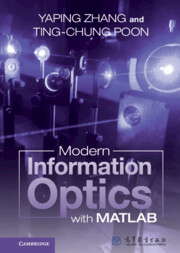Book contents
- Frontmatter
- Dedication
- Contents
- Preface
- 1 Gaussian Optics and Uncertainty Principle
- 2 Linear Invariant Systems and Fourier Analysis
- 3 Wave Propagation and Wave Optics
- 4 Spatial Coherent and Incoherent Optical Systems
- 5 Principles of Coherent Holography
- 6 Digital Holography
- 7 Spatial Light Modulators for Processing Optical Information
- Index
- References
7 - Spatial Light Modulators for Processing Optical Information
Published online by Cambridge University Press: 22 December 2022
- Frontmatter
- Dedication
- Contents
- Preface
- 1 Gaussian Optics and Uncertainty Principle
- 2 Linear Invariant Systems and Fourier Analysis
- 3 Wave Propagation and Wave Optics
- 4 Spatial Coherent and Incoherent Optical Systems
- 5 Principles of Coherent Holography
- 6 Digital Holography
- 7 Spatial Light Modulators for Processing Optical Information
- Index
- References
Summary
In modern optical processing and display applications, there are increased needs of a real-time device and such a device is called a spatial light modulator (SLM). Typical examples of SLMs are acousto-optics modulators (AOMs), electro-optic modulators (EOMs) and liquid crystal displays. In this chapter, we will concentrate on these types of modulators and discuss their uses, such as phase modulation and intensity modulation, in information processing.
Keywords
- Type
- Chapter
- Information
- Modern Information Optics with MATLAB , pp. 260 - 316Publisher: Cambridge University PressPrint publication year: 2023

